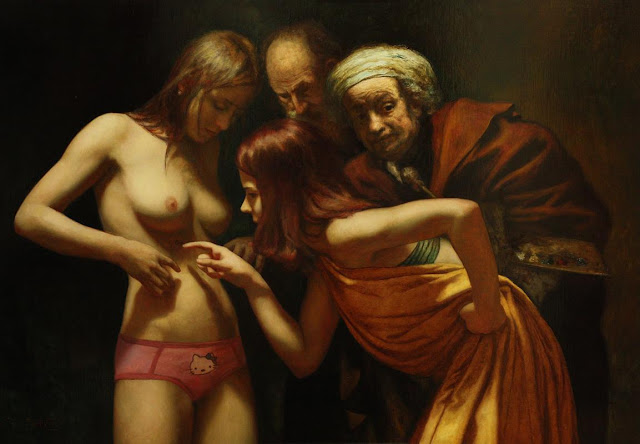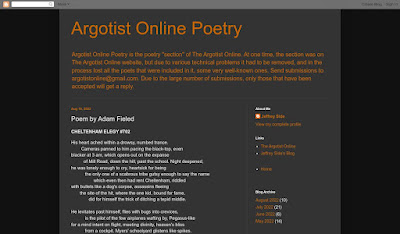Bien
qu'aucun récit soutenu ne le soutienne, Apparition Poems se veut tentaculaire
et épique. Une épopée américaine, même légitime au niveau mondial, ne pouvait
être qu'une épopée composée de parties disparates, apparemment inconciliables -
un tel état de fait étant aussi celui de l'Amérique. Les souches qui s'irritent
et se heurtent dans Apparition Poems sont discrètes - poèmes d'amour, poèmes
charnels, méta-poèmes, poèmes philosophiques, etc. bâillement barbare ») qui
crée un sentiment permanent (pour la durée de l'épopée) de dislocation, de
désorientation et d'inconfort. Ceci est renforcé par les nuances des poèmes
individuels, qui sont souvent façonnés dans le dialecte de multiples
significations et insinuations. Presque tous les signes linguistiques dans
Apparition Poems sont bifurqués; soit par le contexte de sa relation avec
d'autres signes linguistiques dans les poèmes, soit par sa relation avec
l'ensemble épique du livre lui-même. Si Apparition Poems est une épopée, c'est
une épopée du langage ; l'aventure combative de multiples significations, de
contextes et de perspectives changeants, et le désespoir ultime de
l'incommensurabilité de l'expression astucieuse avec la vie pratique à une
époque de déclin matériel et spirituel. Il est significatif que les poèmes
soient numérotés plutôt que nommés; il met l'accent sur le caractère
fragmentaire (ou apparitionnel) de chacun, sa place dans une sorte de mosaïque,
plutôt qu'une série d'ensembles soudés ensemble par hasard ou par volonté
arbitraire (comme c'est de rigueur pour les textes poétiques).
C'est la
dichotomie des poèmes d'apparition - les épopées, au sens classique, sont
censées représenter une action continue et cohérente - la continuité narrative
est essentielle. Apparition Poems est une épopée en fragments – chaque poème
nous plonge, in medias res, dans un nouveau récit. Si je choisis d'appeler
Apparition Poems une épopée, non pas au sens classique (ou miltonien) mais dans
un nouveau mode américain (qui maintient néanmoins certaines conventions classiques),
c'est parce que les fragments créent ensemble une ampleur qui peut être
confortablement appelé épique. L'action représentée dans les poèmes va du
sublime au ridicule, de l'héroïque à l'anti-héroïque ; il y a des monologues
dramatiques placés au milieu des autres formes, de sorte que le livre ne
s'éloigne jamais trop de l'humanisme direct et directement représenté et de
l'effort humaniste. Le personnage américain est maussade s'il n'est pas capable
de rivaliser - les personnages ici le sont aussi. La vie dégénère en concours
et en quête de victoire, même dans des contextes paisibles ou solitaires.
Pourtant, si le paysage indigène est étrange et surréaliste, il est difficile
de maintenir des attitudes compétitives directes - la conscience doit s'adapter
tout en rivalisant, créant un dilemme loin de la singularité effrontée qui a
défini le succès et le militarisme Americadans le monde.
Soudain,
la conscience américaine est assiégée par des sables mouvants et des
significations multiples - une incapacité, non seulement à être singulier mais
à percevoir des significations singulières. Même si les multiplications sont
résistées, tout se multiplie, et souvent en perte de profit, plutôt qu'en gain
de profit. Le récit épique et fragmentaire d'Apparition Poems est un récit
tragique et descendant, plutôt qu'une histoire de bravoure ou d'héroïsme. La
consolation pour la perte de consonance matérielle est une vision plus réaliste
du monde et de la vie humaine - comme un site de/pour le dynamisme, plutôt que
la stase, de/pour la multiplicité, plutôt que la singularité. Apparition Poems
est une vue sur « multipleAmerica »
de Philadelphia,
son lieu de naissance , et une ville assiégée également par de multiples
visions d'elle-même. Aucune ville American'a autant de poids
historique; et aucune ville américaine n'a subi une rétrogradation aussi dure
au XXe siècle brutalement matérialiste. Pourtant, comme le suggère Apparition
Poems, si une nouveauté Americadoit
se manifester au XXIe siècle, autant commencer en Philadelphia. Si l'épopée se concentre sur la
perte suivie de plus de perte, plutôt que sur un éventuel triomphe complet,
alors qu'il en soit ainsi. Et si Apparition Poems en tant qu'épopée
fragmentaire impose une leçon, c'est celle-ci : la poursuite de la singularité
dans la vie humaine est un jeu de dupe ; la vérité est presque toujours, et
triomphalement, multiple.
……………………………………………………………………………………………
Avec
douze ans de recul, et avec un sentiment d'affection pour le texte, combiné
avec une reconnaissance que je suis en partie archi, il me semble que
Apparition Poems s'est imposé comme un livre moins que sain . Le sens,
dans le texte, à la fois de la perversité et de la perversion au sens général,
créant des angles textuels censés couper ou inciser plutôt que (comme c'est
plus habituel en Amérique) caresser, faire une approche de ce texte après
toutes ces années ce qui pourrait , éventuellement, être considéré comme
superflu. Le problème d'un renvoi brusque, et c'est un problème moins que
sain , c'est le recours du livre à la philosophie et à la pensée
philosophique, toujours dans les limites de l'esthétisation, comme un voyage
atteint ou tenté au-delà de la perversion, ou dans la perversion.
transcendentalisé à nouveau en allégorie, métaphore chargée et réinvention
formelle. Une fois que la poésie ici a tenté un rapport avec les fréquences
supérieures de la pensée discursive, nous en déduisons qu'une interrogation est
nécessaire pour savoir si ce rapport est possible, de manière réelle, du tout.
Pour répondre à cette question, il faut d'abord s'interroger aussi, même à plus
grand air qu'on ne voudrait, quel rapport est possible entre la poésie et la
philosophie ; une enquête plus approfondie, lorsque nous comprenons quelles
sont les possibilités, si cette forme ou cette manière ou ce rapport est
souhaitable ou non.
L'apparition
qui hante le livre : un sentiment de profondeur et de solidité, contenu dans
une conscience individuelle ; un sentiment de salubrité; conduit le
protagoniste au-delà du paysage du charnel et des enquêtes jéjuines sur le
langage, qui ne parviennent pas à atteindre plus intellectuellement que la
stylisation ou les modes stylisés de disjonction et de déconstruction. Le seul
oxygène qui lui parvienne, qui puisse propulser les éclats d'une conscience
décimée dans au moins une imagination de la salubrité, est celui fourni
par un abandon désespéré à des discours visant plus haut que le langage
esthétisé est destiné à atteindre, et aux conditions et termes que offre
esthétique généralement. L'image se pose d'une figure de Don Quichotte,
arpentant les rues du centre-ville de Philadelphie au milieu de la nuit. Dans
l'état de perversité, de perversion et de moins-que-sain dans lequel le livre a
été écrit ; une sorte de transe; il n'est jamais venu à l'esprit de l'auteur
qu'une dépendance à l'esthétique, et à la stylisation en général, pourrait
céder la place à la limpidité si le contrôle était abandonné dans ces espaces
discursifs plus limpides. Au contraire, bifurquer le philosophique afin qu'il
puisse également remplir les conditions de l'esthétique et de la stylisation,
semblait une tactique viable pour donner libre cours à ce sens du fragmenté, du
déchiqueté, de l'incisivement pointu, qui animait sa conscience.
Philosophie,
et le discours philosophique, vise, à son paroxysme, la vérité la plus
objective. Le langage devient un conduit pour des perspectives ouvertes,
censées répondre à des questions auxquelles les quantifications des
scientifiques ne peuvent répondre - l'être des êtres, la nature précise de la
conscience humaine elle-même. L'objectif du poète est davantage une forme
sophistiquée de divertissement - le langage comme conduit pour la poursuite de
la somptuosité, l'imagination tendue pour rendre les choses, ou les
choses-du-monde, transitives vers d'autres choses (métaphore), ainsi qu'un
version compromise de l'objectivité, fonctionnant en équilibre harmonieux avec
les impératifs de l'imagination et de la mélopée . L'échange réel
possible entre philosophie et poésie est donc un emprunt, par la poésie, d'une
lentille plus objective pour regarder les objets traditionnels de la poésie -
eros, affectivité, créativité métaphorique. Ce que la philosophie peut
reprendre, à son tour, c'est quelque chose d'utile par intermittence au
philosophe et à ses discours - une jouissance ou un jeu des sens dans un mode
inférieur de discours - des eaux plus chaudes, quoique finalement moins
nourrissantes, pour barboter.
L'attribution
de désirabilité ou non désirabilité à cet ensemble de circonstances manifeste
un sentiment d'ambiguïté, auquel seuls des individus forcés de l'affronter
peuvent répondre. Si je continue d'apposer ma propre attribution de moins-que-sain
aux poèmes d'apparition, c'est parce que le moment où la philosophie
apparaît dans le livre a une charnière avec une esthétique poétique moins que
traditionnelle, qui substitue la rancœur, la discorde et une explosivité
sémantique/syntaxique, dans plusieurs directions, pour la somptuosité, et des
métaphores construites et perpétuées dans un théâtre textuel de la cruauté,
pour emprunter à Artaud, qui repoussent toutes les limites de ce qui pourrait
être considéré comme divertissant, pour les poursuites conventionnelles de la
poésie. Le divertissement qui pourrait alors découler des Apparition Poems
serait l'émergence de la philosophie, comme antidote objectif à une
subjectivité jaunie par l'immersion dans une jungle de métaphores trop
tranchantes et hostiles - ainsi aliénées à la salubrité de l'esthétique
conventionnelle.
En tant
qu'individu, confronté à un texte, il peut être reconnu ou non que les poèmes
d'apparition créent de nouvelles eaux pour que les discours supérieurs jouent
dans le jeu, ici, étant une fonction de métaphores-jouets, de paysages
esthétiques comme terrains de jeu, de syndromes idiosyncrasiques. comme
vecteurs d'une possible universalisation. Le livre, en d'autres termes, ne peut
pas se guérir, se rendre sain - bien que, par son sens d'atteindre la
philosophie, il essaie - mais la philosophie elle-même, s'engageant ici dans un
mode d'investigation (pillant le Théâtre de la Cruauté pour des points
d'intérêt) peut faire pour le livre, ce que le livre ne peut pas faire pour
lui-même. Si tout cela se passe dans une ambiance de malice, de transgression
volontaire, tant mieux.
























